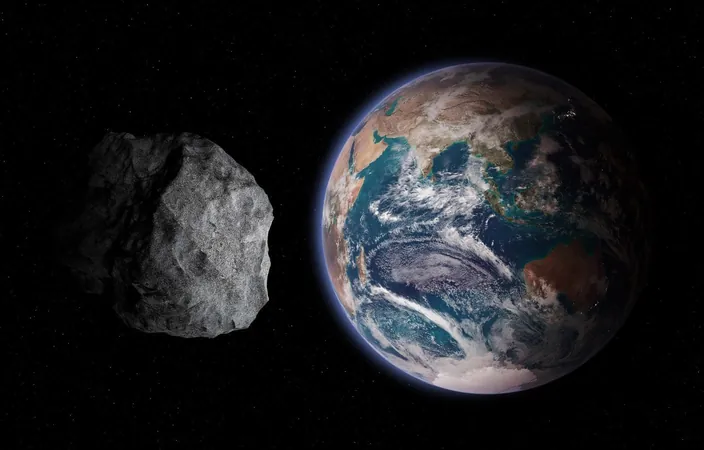
Asteroid Apophis: A Groundbreaking Space Mission for 2029’s Close Encounter!
2024-11-20
Author: William
Asteroid Apophis: A Groundbreaking Space Mission for 2029’s Close Encounter!
As we gaze upon the wonders of the universe, the astronomical event slated for April 13, 2029, stands out as a once-in-a-lifetime occurrence. On this day, the colossal asteroid Apophis—named after the ancient Egyptian god of chaos—will soar just 19,635 miles (31,600 kilometers) from Earth. This massive rock, measuring approximately 375 meters wide, is larger than 90% of known asteroids and will be visible to the naked eye across Europe, Africa, and Asia.
Why This Matters: A Once-in-10,000-Year Event
Asteroids of Apophis's magnitude come near our planet only every 5,000 to 10,000 years. To put this into perspective, while total solar eclipses happen about every 18 months, and Halley's Comet graces our skies every 76 years, the rarity of Apophis's encounter makes this event exceptionally significant. With its trajectory taking it between Earth's geostationary satellites and the Atlantic Ocean, this flyby will be the closest any asteroid has approached Earth in recorded history.
Enter RAMSES: The Future of Planetary Defense
In response to the remarkable opportunity presented by this close encounter, the European Space Agency has initiated an exciting mission named the Rapid Apophis Mission for Space Safety (RAMSES). Scheduled for launch in April 2028, the RAMSES spacecraft will rendezvous with Apophis by February 2029 and will closely monitor the asteroid during its flyby.
This mission aims to gather invaluable data on the asteroid's shape, surface characteristics, orbital mechanics, and response to Earth’s gravitational forces. Such information is critical for future planetary defense strategies, especially as we learn how external forces can influence an asteroid's trajectory—vital knowledge for potential deflection missions should an asteroid pose a threat.
A Natural Laboratory: Apophis Under Observation
“Nature is providing us with a natural laboratory,” explains Patrick Michel, Director of Research at CNRS at Observatoire de la Côte d'Azur in Nice, who is actively working on the RAMSES mission. He emphasizes the unique opportunity presented by Apophis, allowing scientists to observe how it experiences tidal forces, potentially leading to landslides and the exposure of new materials from its depths. This could offer insights into the building blocks of our solar system, dating back over four billion years.
While earlier discovered in 2004, concerns about Apophis striking Earth within the following century have been put to rest. Astrophysicists now confirm that it won’t pose a threat for at least the next hundred years, although its flyby in 2029 remains a point of interest, as Earth’s gravity may alter its orbital path.
A Dual Mission: NASA Joins the Expedition
The excitement surrounding Apophis doesn't stop there. Just a month after the RAMSES mission's observations, NASA's OSIRIS-REx spacecraft will also be paying a visit, transitioning to a new mission as OSIRIS-APEX. This dual mission approach helps ensure complementary data on the asteroid’s characteristics before and after its swing by Earth. “RAMSES will showcase humanity's ability to respond to an incoming asteroid,” states Richard Moissl, head of ESA’s Planetary Defence Office, underscoring its significance in our planetary safety efforts.
What Lies Ahead for Asteroid Apophis?
Apophis is categorized as an S-type stony asteroid, completing its orbit around the sun every 324 days. Its headlines-grabbing potential was once attributed to calculated risks of impacts in 2029, 2036, and 2068; however, these fears have been alleviated, with predictions now indicating safety for at least a century.
As we look forward to what promises to be an awe-inspiring astronomical event, we invite you to keep an eye on the skies. Could this be the beginning of a new era in asteroid exploration and planetary defense? Only time will tell! Don't forget to mark your calendars!









 Brasil (PT)
Brasil (PT)
 Canada (EN)
Canada (EN)
 Chile (ES)
Chile (ES)
 España (ES)
España (ES)
 France (FR)
France (FR)
 Hong Kong (EN)
Hong Kong (EN)
 Italia (IT)
Italia (IT)
 日本 (JA)
日本 (JA)
 Magyarország (HU)
Magyarország (HU)
 Norge (NO)
Norge (NO)
 Polska (PL)
Polska (PL)
 Schweiz (DE)
Schweiz (DE)
 Singapore (EN)
Singapore (EN)
 Sverige (SV)
Sverige (SV)
 Suomi (FI)
Suomi (FI)
 Türkiye (TR)
Türkiye (TR)